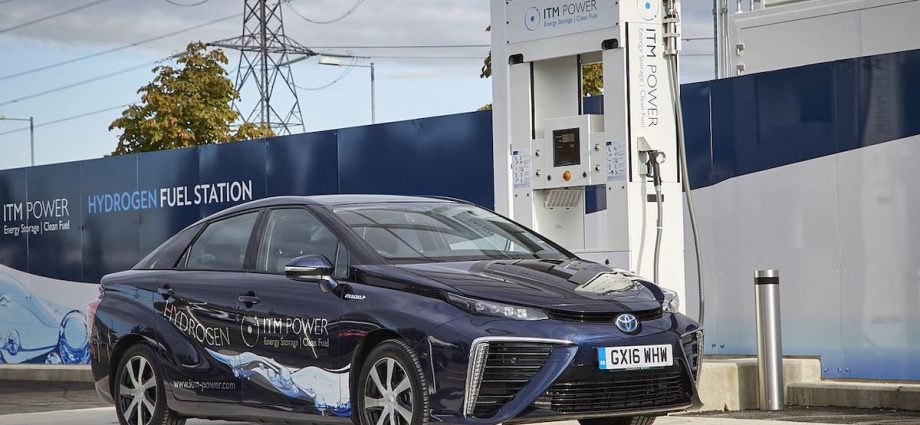
With a changing of the guard at the top of the world’s biggest carmaker, Toyota, there’s an opportunity for the company to rethink its stance on hydrogen.
Outgoing chief executive officer Akio Toyoda has been the most outspoken on hydrogen of any automaker, framing it as a serious competitor to battery electric vehicles.
But this narrative looks less believable every year. Here’s why.
Physics
Hydrogen is just an energy carrier – we have to make it – and currently 99% of hydrogen is made using fossil fuels.
We absolutely need to replace that existing fossil hydrogen with “green” hydrogen – made by splitting water using renewables-based electricity – to use in industrial sectors that don’t have many alternatives.
But using this energy-intensive, scarce, expensive and hard-to-handle green hydrogen to power a car is a terrible idea, from an engineering perspective.
Instead of charging a battery directly, we add multiple stages of energy conversion: electrolysis of water, compression and storage of hydrogen gas or liquefaction to make it an ultra-cold liquid, and conversion back to electricity in a fuel cell. This process chain wastes about 75-80% of the renewable energy.
The result is that it takes three times as much energy to propel a hydrogen-fuel-cell vehicle 1 kilometer than a battery vehicle. Without government subsidies, this means that the energy costs three times as much. (It’s unclear how hydrogen fits into Toyota’s corporate philosophy of continuous efficiency improvement.)
The world faces a daunting challenge to ramp up renewables fast enough to meet safe climate goals. To ask society to build triple the amount of solar and wind capacity that we need to power EVs, for no extra climate benefit, but just so Toyota can sell inefficient cars, is unacceptable.
The market has already decided
Toyota argues that governments should not “pick winners” – and it’s right. But governments have been technology-neutral on the auto sector, merely setting a date by which all new vehicles must emit zero carbon dioxide, and leaving it up to the industry, markets, and consumers to decide how to eliminate those CO2 emissions.
Now that the industry has trialed EVs, hydrogen and various alternative fuels for decades, the results are in: EVs have won hands down.
Last year EVs surged to more than 10% of global car sales, or around 7.8 million units, up a whopping 68% year on year.
Hydrogen vehicles meanwhile were 0.2% of that, at 18,892 sold in 2022.
Toyota argues that EVs are not affordable for everyone. But hydrogen vehicles are more expensive than EVs to build.
Under the hood, a hydrogen-powered vehicle has the same components as a battery electric vehicle (just with a smaller battery) but with the addition of hydrogen storage tanks, complex hydrogen delivery equipment and an expensive fuel cell. This makes it inherently more costly than a battery EV.
There’s a price war happening in the EV market, as volumes and the number of models surge. Tesla recently dropped the price of its Model 3 sedan to almost US$5,000 less than the average new car cost. A new electric Chevy Bolt starts at under $27,000. Meanwhile Toyota’s hydrogen-fueled Mirai model starts at more than $50,000.
Hydrogen harder for consumers to adopt
Toyota has also cast doubt on electric vehicles by claiming the charging infrastructure is not ready.
In fact, most EV drivers plug in at home. Moreover, public charging infrastructure is booming and widespread in the major car markets of China, the US and Europe. In this comparison, hydrogen is again the loser, with very little refueling infrastructure outside of California, and some hydrogen fueling stations in the UK being shut down.
EVs can piggyback on existing electricity grids in all developed countries, and even countries currently lacking reliable grids have achievable plans to build them. But national hydrogen refueling infrastructure remains a pipe dream even for wealthy nations.
Why does all this matter? Because hydrogen is distracting from, and delaying progress on, decarbonization.
The need to wait perpetually for further research and development on hydrogen cars before they become commercially viable is a considerable downside. But a cynic could argue that’s the main point of this technology, for any incumbents keen to prolong their main business of selling combustion-engine cars.
Experts in this field, such as the founder of BloombergNEF Michael Liebreich, have also voiced this concern. Every year that governments and consumers wait for hydrogen cars, Toyota adds more than 9 million combustion cars to the roads.
Even if we wait until the end of this decade, S&P Global Mobility data forecast that Toyota will still only sell around 8,000 hydrogen cars in 2029 – about one thousandth of its projected annual combustion-engine vehicle sales of well over 10 million.
Toyota’s world-class engineers undoubtedly understand all of the above already. The company’s bullish hydrogen stance is probably more about marketing than engineering.
But as regulators and the public grow less accepting of greenwashing, this type of marketing tactic is on its last legs.
It is in the interests of Toyota, its investors, the planet and the increasingly climate-concerned public that new CEO Koji Sato axes the company’s futile plans for hydrogen cars on his first day, and commits to a 100% electric future.

